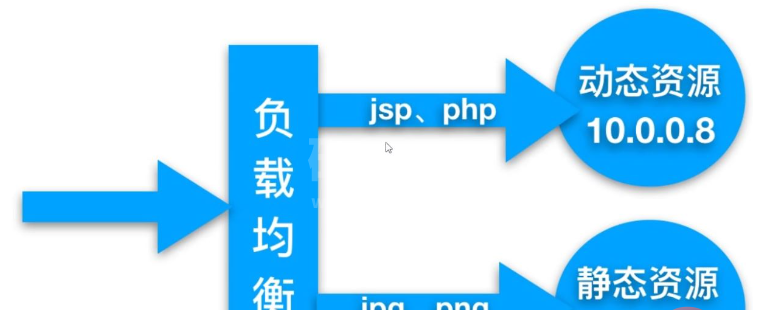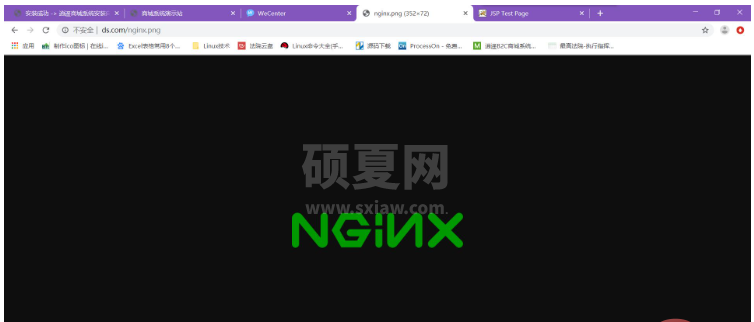Nginx动静分离及配置的方法是什么
1.Nginx动静分离概念
动静分离,通过中间件将动态请求和静态请求进行分离,分离资源,减少不必要的请求消耗,减少请求延时。
好处:动静分离后,即使动态服务不可用,但静态资源不会受到影响
通过中间件可以将动态请求和静态请求进行分离

2.Nginx动静分离应用案例

2.1.环境规划
| 系统 | 服务 | 服务 | 地址 |
| centos7.5 | 负载均衡 | Nginx proxy | 192.168.81.210 |
| centos7.5 | 静态资源 | Nginx static | 192.168.81.220 |
| centos7.5 | 动态资源 | Tomcat server | 192.168.81.230 |
2.2.配置静态资源
1.创建动静分离配置文件 [root@localhost ~]# cd /etc/nginx/conf.d/ [root@localhost conf.d]# vim ds.conf #动静分离 server { listen 80; server_name ds.com; location / { root /web; index index.html; } location ~* .*\.(png|jpg|gif)$ { root /web/images; } } 2.重载Nginx [root@localhost conf.d]# nginx -t nginx: the configuration file /etc/nginx/nginx.conf syntax is ok nginx: configuration file /etc/nginx/nginx.conf test is successful [root@localhost conf.d]# systemctl reload nginx 3.准备图片 [root@localhost conf.d]# mkdir /web/images [root@localhost conf.d]# wget -O /web/images/nginx.png http://nginx.org/nginx.png

2.3.配置动态资源
1.编译安装tomcat
[root@localhost soft]# tar xf apache-tomcat-7.0.92.tar.gz -C /application/
2.写入动态文件
[root@localhost soft]# cd /application/
[root@localhost application]# vim apache-tomcat-7.0.92/webapps/ROOT/java_test.jsp
<%@ page language="java" import="java.util.*" pageEncoding="utf-8"%>
<HTML>
<HEAD>
<TITLE>JSP Test Page</TITLE>
</HEAD>
<BODY>
<%
Random rand = new Random();
out.println("<h2>Random number:</h2>");
out.println(rand.nextInt(99)+100);
%>
</BODY>
</HTML>
3.启动服务
[root@localhost application]# cd apache-tomcat-7.0.92/
[root@localhost apache-tomcat-7.0.92]# ./bin/startup.sh2.4.整合动静分离
2.4.1.配置动静分离负载均衡
[root@localhost conf.d]# vim lb_ds.conf
#整合动静分离
upstream static_photo {
server 172.16.1.20:80;
}
upstream java {
server 172.16.1.30:8080;
}
server {
listen 80;
server_name ds.com;
access_log /nginx_log/lb_ds_access.log main;
location / {
root /web/ds;
index index.html;
}
location ~* .*\.(jpg|png|gif)$ {
proxy_pass http://static_photo;
proxy_set_header HOST $http_host;
proxy_set_header X-Real-IP $remote_addr;
proxy_set_header X-Forwarded-For $proxy_add_x_forwarded_for;
}
location ~* .jsp$ {
proxy_pass http://java;
proxy_set_header HOST $http_host;
proxy_set_header X-Real-IP $remote_addr;
proxy_set_header X-Forwarded-For $proxy_add_x_forwarded_for;
}
}2.4.2.编写整合动静分离代码
[root@localhost conf.d]# vim /web/ds/index.html
<html lang="en">
<head>
<meta charset="UTF-8" />
<title>测试动静分离</title>
<script src="http://libs.baidu.com/jquery/2.1.4/jquery.min.js"></script>
</head>
<script type="text/javascript">
$(document).ready(function(){
$.ajax({
type: "GET",
url: "http://ds.com/java_test.jsp",
success: function(data) {
$("#get_data").html(data)
},
error: function() {
alert("fail!!,请刷新再试");
}
});
});
</script>
<body>
<h2>测试动静分离</h2>
<h2>上面为静态图片,下面为动态页面</h2>
<img src="http://ds.com/nginx.png">
<div id="get_data"></div>
</body>
</html>2.5.效果
看着是一个页面实则不同机器在做处理

以上就是Nginx动静分离及配置的方法是什么的详细内容,更多请关注www.sxiaw.com其它相关文章!
